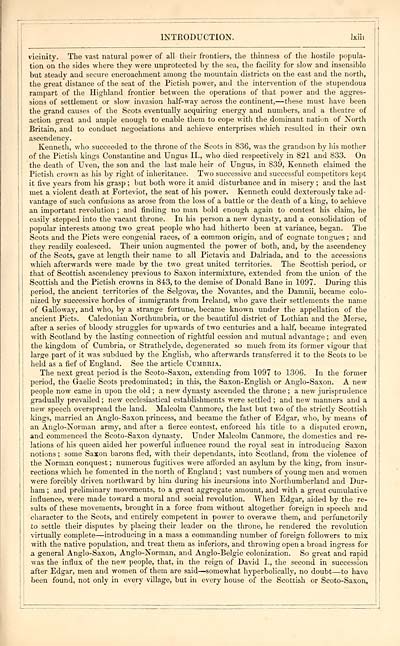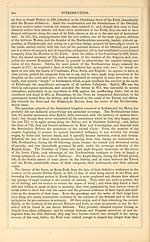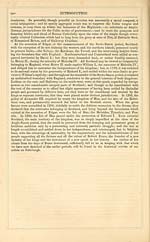Imperial gazeteer of Scotland, or, Dictionary of Scottish topography > Volume 1
(77) Page lxiii
Download files
Complete book:
Individual page:
Thumbnail gallery: Grid view | List view

INTRODUCTION. Ixiii
vicinity. The vast natural power of all their frontiers, the thinness of the hostile popula-
tion on the sides where they were unprotected by the sea, the facility for slow and insensiblo
but steady and secure encroachment among the mountain districts on the east and the north,
the great distance of the seat of the Pictish power, and the intervention of the stupendous
rampart of the Highland frontier between the operations of that power and the aggres-
sions of settlement or slow invasion half-way across the continent, — these must have been
the grand causes of the Scots eventually acquiring energy and numbers, and a theatre of
action great and ample enough to enable them to cope with the dominant nation of North
Britain, and to conduct negociations and achieve enterprises which resulted in their own
ascendency.
Kenneth, who succeeded to the throne of the Scots in 836, was the grandson by his mother
of the Pictish kings Constantine and Ungus II., who died respectively in 821 and 833. On
the death of Uven, the son and the last male heir of Ungus, in 839, Kenneth claimed the
Pictish crown as his by right of inheritance. Two successive and successful competitors kept
it five years from his grasp ; but both wore it amid disturbance and in misery ; and the last
met a violent death at Forteviot, the seat of his power. Kenneth could dexterously take ad-
vantage of such confusions as arose from the loss of a battle or the death of a king, to achieve
an important revolution ; and finding no man bold enough again to contest his claim, he
easily stepped into the vacant throne. In his person a new dynasty, and a consolidation of
popular interests among two great people who had hitherto been at variance, began. The
Scots and the Picts were congenial races, of a common origin, and of cognate tongues ; and
they readily coalesced. Their union augmented the power of both, and, by the ascendency
of the Scots, gave at length their name to all Pictavia and Dalriada, and to the accessions
which afterwards were made by the two great united territories. The Scottish period, or
that of Scottish ascendency previous to Saxon intermixture, extended from the union of the
Scottish and the Pictish crowns in 843, to the demise of Donald Bane in 1097. During this
period, the ancient territories of the Selgovse, the Novantes, and the Damnii, became colo-
nized by successive hordes of immigrants from Ireland, who gave their settlements the name
of Galloway, and who, by a strange fortune, became known under the appellation of the
ancient Picts. Caledonian Northumbria, or the beautiful district of Lothian and the Merse,
after a series of bloody struggles for upwards of two centuries and a half, became integrated
with Scotland by the lasting connection of rightful cession and mutual advantage ; and even
the kingdom of Cumbria, or Strathclyde, degenerated so much from its former vigour that
large part of it was subdued by the English, who afterwards transferred it to the Scots to be
held as a fief of England. See the article Cumbria.
The next great period is the Scoto-Saxon, extending from 1097 to 1306. In the former
period, the Gaelic Scots predominated; in this, the Saxon-English or Anglo-Saxon. A new
people now came in upon the old ; a new dynasty ascended the throne ; a new jurisprudence
gradually prevailed ; new ecclesiastical establishments were settled ; and new manners and a
new speech overspread the land. Malcolm Canmore, the last but two of the strictly Scottish
Icings, married an Anglo-Saxon princess, and became the father of Edgar, who, by means of
an Anglo-Norman army, and after a fierce contest, enforced his title to a disputed crown,
and commenced the Scoto-Saxon dynasty. Under Malcolm Canmore, the domestics and re-
lations of his queen aided her powerful influence round the royal seat in introducing Saxon
notions ; some Saxon barons fled, with their dependants, into Scotland, from the violence of
the Norman conquest ; numerous fugitives were afforded an asylum by the king, from insur-
rections which he fomented in the north of England ; vast numbers of young men and women
were forcibly driven northward by him during his incursions into Northumberland and Dur-
ham ; and preliminary movements, to a great aggregate amount, and with a great cumulative
influence, were made toward a moral and social revolution. When Edgar, aided by the re-
sults of these movements, brought in a force from without altogether foreign in speech and
character to the Scots, and entirely competent in power to overawe them, and perfunctorily
to settle their disputes by placing their leader on the throne, he rendered the revolution
virtually complete — introducing in a mass a commanding number of foreign followers to mix
with the native population, and treat them as inferiors, and throwing open a broad ingress for
a general Anglo-Saxon, Anglo-Norman, and Anglo-Belgic colonization. So great and rapid
was the influx of the new people, that, in the reign of David I., the second in succession
after Edgar, men and women of them are said — somewhat hyperbolically, no doubt — to have
been found, not only in every village, but in every house of the Scottish or Scoto-Saxon,
vicinity. The vast natural power of all their frontiers, the thinness of the hostile popula-
tion on the sides where they were unprotected by the sea, the facility for slow and insensiblo
but steady and secure encroachment among the mountain districts on the east and the north,
the great distance of the seat of the Pictish power, and the intervention of the stupendous
rampart of the Highland frontier between the operations of that power and the aggres-
sions of settlement or slow invasion half-way across the continent, — these must have been
the grand causes of the Scots eventually acquiring energy and numbers, and a theatre of
action great and ample enough to enable them to cope with the dominant nation of North
Britain, and to conduct negociations and achieve enterprises which resulted in their own
ascendency.
Kenneth, who succeeded to the throne of the Scots in 836, was the grandson by his mother
of the Pictish kings Constantine and Ungus II., who died respectively in 821 and 833. On
the death of Uven, the son and the last male heir of Ungus, in 839, Kenneth claimed the
Pictish crown as his by right of inheritance. Two successive and successful competitors kept
it five years from his grasp ; but both wore it amid disturbance and in misery ; and the last
met a violent death at Forteviot, the seat of his power. Kenneth could dexterously take ad-
vantage of such confusions as arose from the loss of a battle or the death of a king, to achieve
an important revolution ; and finding no man bold enough again to contest his claim, he
easily stepped into the vacant throne. In his person a new dynasty, and a consolidation of
popular interests among two great people who had hitherto been at variance, began. The
Scots and the Picts were congenial races, of a common origin, and of cognate tongues ; and
they readily coalesced. Their union augmented the power of both, and, by the ascendency
of the Scots, gave at length their name to all Pictavia and Dalriada, and to the accessions
which afterwards were made by the two great united territories. The Scottish period, or
that of Scottish ascendency previous to Saxon intermixture, extended from the union of the
Scottish and the Pictish crowns in 843, to the demise of Donald Bane in 1097. During this
period, the ancient territories of the Selgovse, the Novantes, and the Damnii, became colo-
nized by successive hordes of immigrants from Ireland, who gave their settlements the name
of Galloway, and who, by a strange fortune, became known under the appellation of the
ancient Picts. Caledonian Northumbria, or the beautiful district of Lothian and the Merse,
after a series of bloody struggles for upwards of two centuries and a half, became integrated
with Scotland by the lasting connection of rightful cession and mutual advantage ; and even
the kingdom of Cumbria, or Strathclyde, degenerated so much from its former vigour that
large part of it was subdued by the English, who afterwards transferred it to the Scots to be
held as a fief of England. See the article Cumbria.
The next great period is the Scoto-Saxon, extending from 1097 to 1306. In the former
period, the Gaelic Scots predominated; in this, the Saxon-English or Anglo-Saxon. A new
people now came in upon the old ; a new dynasty ascended the throne ; a new jurisprudence
gradually prevailed ; new ecclesiastical establishments were settled ; and new manners and a
new speech overspread the land. Malcolm Canmore, the last but two of the strictly Scottish
Icings, married an Anglo-Saxon princess, and became the father of Edgar, who, by means of
an Anglo-Norman army, and after a fierce contest, enforced his title to a disputed crown,
and commenced the Scoto-Saxon dynasty. Under Malcolm Canmore, the domestics and re-
lations of his queen aided her powerful influence round the royal seat in introducing Saxon
notions ; some Saxon barons fled, with their dependants, into Scotland, from the violence of
the Norman conquest ; numerous fugitives were afforded an asylum by the king, from insur-
rections which he fomented in the north of England ; vast numbers of young men and women
were forcibly driven northward by him during his incursions into Northumberland and Dur-
ham ; and preliminary movements, to a great aggregate amount, and with a great cumulative
influence, were made toward a moral and social revolution. When Edgar, aided by the re-
sults of these movements, brought in a force from without altogether foreign in speech and
character to the Scots, and entirely competent in power to overawe them, and perfunctorily
to settle their disputes by placing their leader on the throne, he rendered the revolution
virtually complete — introducing in a mass a commanding number of foreign followers to mix
with the native population, and treat them as inferiors, and throwing open a broad ingress for
a general Anglo-Saxon, Anglo-Norman, and Anglo-Belgic colonization. So great and rapid
was the influx of the new people, that, in the reign of David I., the second in succession
after Edgar, men and women of them are said — somewhat hyperbolically, no doubt — to have
been found, not only in every village, but in every house of the Scottish or Scoto-Saxon,
Set display mode to: Large image | Transcription
Images and transcriptions on this page, including medium image downloads, may be used under the Creative Commons Attribution 4.0 International Licence unless otherwise stated. ![]()
| Gazetteers of Scotland, 1803-1901 > Imperial gazeteer of Scotland, or, Dictionary of Scottish topography > Volume 1 > (77) Page lxiii |
|---|
| Permanent URL | https://digital.nls.uk/97460054 |
|---|
| Description | Volume I: Aan-Gordon. |
|---|---|
| Attribution and copyright: |
|

